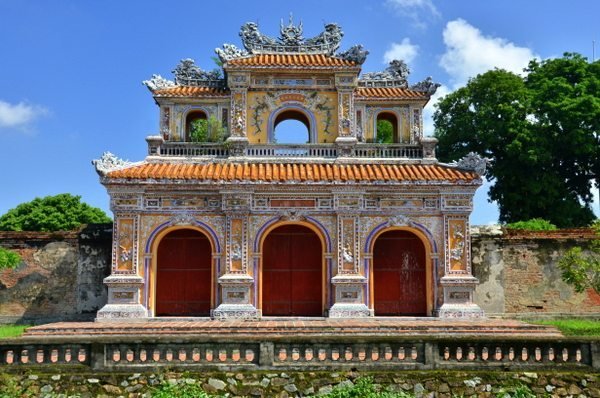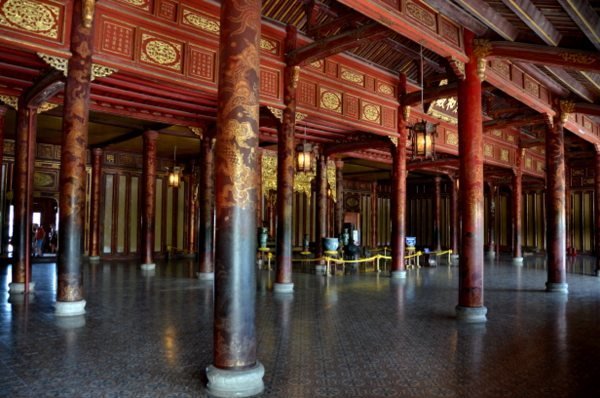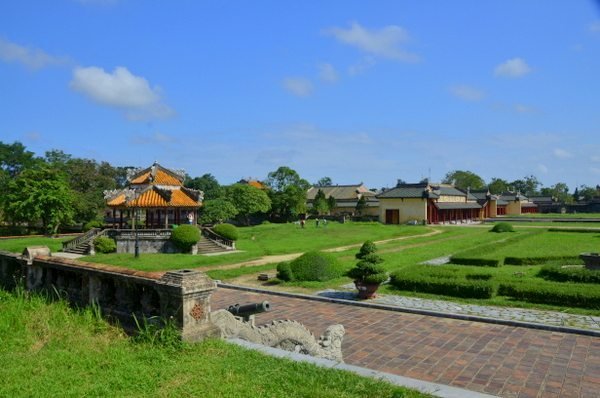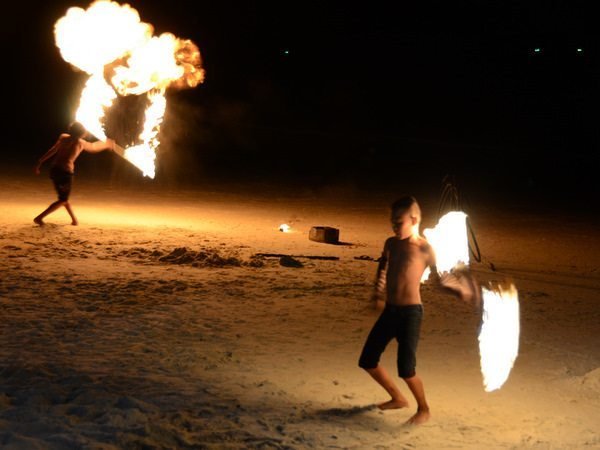Hue: Vietnam’s Imperial City

Huế is pronounced “hway” with a sort of rising tone that may sound like someone asking for clarification: hway?
Gentle and wide, the Perfume River winds its way to the sea from the nearby mountains, right through the heart of the city and past its former fortress and imperial palace. Modern Hue, with fewer than 360,000 residents, has less of a frenetic buzz to it than Ho Chi Minh City or the capital Hanoi, and in the evening it can seem downright sleepy by comparison. But nowhere else in the nation are Vietnam’s years of empire more apparent. While the modern capital of Vietnam is Hanoi, and many are familiar with Ho Chi Minh City (Saigon) as the former seat of South Vietnam, the last imperial family, the emperors of the Nguyen dynasty, called Hue home from 1802 to 1945.
The location of the imperial capital wasn’t just for the natural beauty, but a matter of feng shui. The mountains to the south act as a screen to protect the entrance to the city and keep bad spirits at bay. Within the river flowing past the Citadel’s south side are two islands representing a dragon and a tiger, also spiritual protectors.

The Final Dynasty
Previous emperors in other dynasties had ruled from Hue, then known as Phu Xuan, when civil wars and power struggles among feudal lords moved the map lines about. The Le dynasty survived into the 18th century but ruled in name only from Hanoi. Feudal families – the Trinh in the north and the Nguyen of Hue in the south – still vied for control. The Tay Son, a period of peasant uprisings, added to the instability. But the Nguyen dynasty, came to power under the military leadership of Nguyen Anh, who made Hue the capital of the empire. He became Emperor Gia Long in 1802, and under his rule, the nation first took the name of Viet Nam. But while the Nguyen dynasty initially ruled a unified Vietnam, the gradual creep of colonialism by the French eventually undermined it.
The Nguyen family offered up thirteen emperors, and outside the modern city nine of their tombs – several of them must-see attractions — can be found out among the hills in beautiful natural settings. Emperors Minh Mang (1820-1841), Thieu Tri (1841-1847), and Tu Duc (1847-1883) pushed back against French colonialism, even seeking to reduce the Catholic population to eliminate outside influence. After Tu Duc’s death, independence quickly began to fade away. When missionaries were arrested for illegal entry to Vietnam, the French took this as an excuse to come in and occupy Indochina. Three subsequent emperors were assassinated all within a year and a fourth held the throne just as long before fleeing into Laos when the French took the palace. In 1888 he was captured and sent into exile in Algeria. The French installed his brother, Dong Khanh, and held all the real power from that point forward.
Three emperors later, Khai Dinh (1916-1925) was given the throne and sold out completely, living in luxury while the people suffered. Needless to say, he wasn’t popular, but his tomb, a blend of Eastern and Western designs, is one of the most visited today due to its size and extravagance. The last emperor, Bao Dai, took the puppet’s throne in 1926 but Vietnam fell under Japanese control during World War II (while France ironically became Germany’s puppet). Finally, in 1945, the last emperor abdicated the throne, turning over Vietnam to the Viet Minh. Hue’s days of imperial prestige were over, and the nation’s long years of war and political turmoil began.
The First Indochina War (or Anti-French Resistance War) saw the destruction of Hue’s Can Chanh Palace. As the city is situated roughly midway between Hanoi and Saigon, and not far from the demilitarized zone during the American War in the 1960s and 70s, it lay between the forces of North and South Vietnam, receiving a beating from the Viet Cong as well as the American forces. By the end of the American War, the imperial complex of 160 buildings was effectively reduced to 10. In addition to the wars, Mother Nature took her toll as well, as recently as 2013, when Typhoon Haiyan battered the impressive main gate. But the walls of the Citadel – with bullet holes and bazooka dents – still stand. Not stubborn, but patient.

The Rebirth of the Imperial City
Since being listed as a UNESCO’s World Heritage Site in 1993, the Vietnamese have been restoring and even rebuilding various parts of the royal grounds with meticulous historical detail. The most recent projects, initiated in 2012, breathe a bit more color into the buildings.
Today the historic Imperial City is a mixture of ruins and finely restored structures. The nine cannons inside the main gate of the Citadel once stood along the moat at the inner were for show. But nevertheless, the French, who saw that they pointed to their established residences to the south of the Citadel, had them turned to the side.

Imperial Hue was set up like Russian matryoshka dolls: a city within a city within a city. Vauban, a French military architect, designed the defenses; a 10-km moat laid out in a large square lies just outside the Citadel’s two-meter-thick stone ramparts. Inside this outer wall near its central southern point is the smaller, rectangular walled-in area of the Imperial City, with a moat of its own. Visitors enter now as they did then: across a short bridge to Ngọ Môn, the main gate to the Imperial City, with five passages through the stone walls under a more ornate second-story pavilion. The central of these gates was reserved for the emperor who could also watch troop displays in the courtyard from the pavilion above.

Beyond the gate past two small lagoons is Thai Hoa Palace, a hall of lacquered timber columns and ornate carvings. Deeper inside the city, at the north and central end of the inner complex, is another wall blocking off the Forbidden Purple City, an area exclusively for the royal family. Some halls are completely restored; others offer only the footprints of foundations. Gardens and pools have returned, and the ceramic details of the tiled roofs gleam in the sunshine.

Guides tell the tales of what’s here and what’s missing, and the expansive grounds offer a rare tranquility in Vietnam. A tour at a minimum is one hour, but one can linger for several and venture into often overlooked spots such as the residential area of the emperor’s mother and grandmother, which is intact. The beautiful Truong San Residence, considered the loveliest spot before its destruction, has had its exterior restored, and other halls and temples have gotten fresh lacquer and woodwork. While the emperors are long gone, a stroll through the Imperial City offers a glimpse into their lavish lives.
While in Hue, I took a private day tour of the city, which included the Citadel/Imperial City, the Dong Ba Market, Thien Mu Pagoda, and two of the imperial tombs (plus lunch at a local monastery). Our guide was flexible letting us stay longer at some sites and linger less at others. We’ve also done the Citadel just on our own and spent longer than we expected. It’s a nice peaceful place, but information on site is lacking a bit.
_____________________________




 ORDER YOUR COPY TODAY!
ORDER YOUR COPY TODAY! ORDER YOUR COPY TODAY!
ORDER YOUR COPY TODAY!
Pingback: Travels of 2014: Looking Back
Yeah. My ancestors used to run that place. Damn communism and the French, I could be a princess. Haha. Thanks for the info.